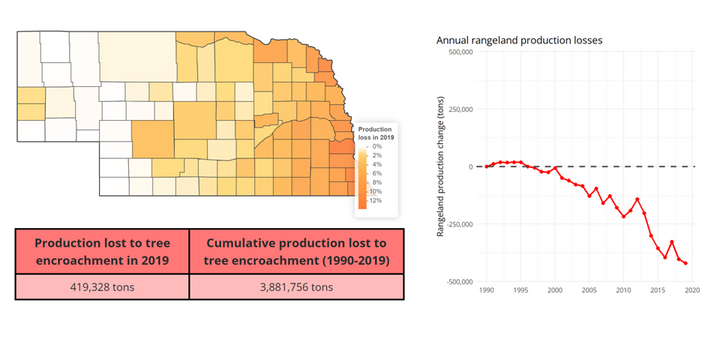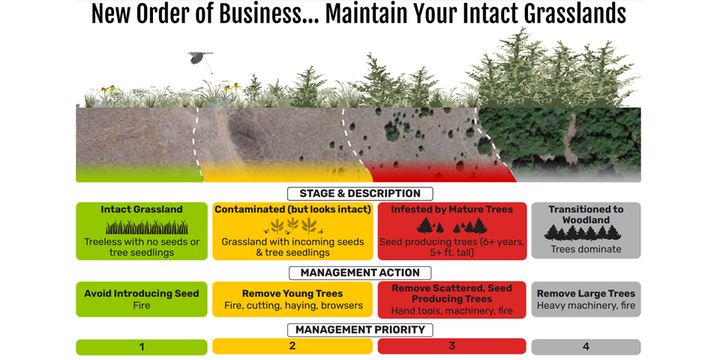Did you know that Nebraska’s grasslands lose over 419,000 tons of forage production every year due to woody plant encroachment? When woody plants like eastern redcedar spread and take over grasslands, they displace grasses and broadleaf plants and reduce forage production by up to 75%1 (Fig.1). New rangeland monitoring data shows that tree cover increased by over 402,000 acres in Nebraska’s rangelands from 1990-2019 (https://www.wlfw.org/yieldgap/). This means less forage for livestock and wildlife needs.

Recent innovations in rangeland monitoring give rangeland experts the ability to track woody encroachment and the associated losses in forage production that occur at county, state, and national levels2. Rangeland production losses are derived based on a 1990 baseline and depict production losses relative to what would have been achievable had tree cover not increased in rangelands since 1990 (historically forested lands are excluded from analysis).
Results confirm an overwhelming trend of woody encroachment in the Great Plains. Annually, 22.4 million tons of rangeland production are lost across the 10-state Great Plains region due to woody encroachment3.
Nebraska has experienced unprecedented losses in forage production due to woody encroachment (Fig. 2). Losses in 2019 alone were equivalent to 698,880 1200-lb round bales and the annual forage need of 88,466 cows (calculated based on 790-lb of forage per Animal Unit Month for a 12-month period)3. The economic damages of lost production in Nebraska’s rangelands were estimated at nearly $18 million in 2019 alone (the most recent year of modeled production losses; economic damages were calculated based on cash rental rates)2,3.

Unprecedented production losses are expected to continue without strategies to defend intact grasslands from encroaching woody plants4. In Nebraska, encroachment-driven losses have swiftly increased since 1990, a trend that’s been repeated in one state after the next as woody plants continue to spread into new grassland regions that have little or no history of encroachment4. Current production losses in Nebraska (419,328 tons) looked like those of Kansas in 2001, over 20 years ago (415,988 tons). However, by 2019, Kansas lost more than 3 times the amount of forage production it lost in 2001, over 1.5 million tons.
Traditional management approaches are unable to prevent losses in forage production because they target the late stages of encroachment, consisting of mature trees and patches of trees, where impacts have already occurred. Management that focuses solely on these stages of encroachment leaves behind seeds and seedlings that set the stage for rapid reinvasion. This results in costly, but short-lived management treatments. Ultimately, this approach does not solve the problem of encroachment and leads to horror stories from the southern Great Plains where the value of the ranch was paid three times over to cover brush management costs.
How to prevent and reverse production losses on your ranch?
New guidelines for reducing woody encroachment emphasize integrated management across all stages of encroachment (Fig. 3)4. This includes keeping intact grasslands intact and reducing grassland exposure to problematic and invasive woody plants and their seeds. Once mature trees are cleared, follow-up treatments are needed to remove seedlings and deplete the seedbank that’s left behind. This approach reduces the risk of reinvasion and extends the lifespan of expensive tree-clearing treatments.

To learn more about management guidelines for reducing woody encroachment, check out the following resources:
- Reducing woody encroachment in grasslands: a guide for understanding risk and vulnerability (available at https://go.unl.edu/o6q9).
- Reducing woody encroachment in grasslands: a pocket guide for planning and design (available at https://go.unl.edu/bsnf as a complementary resource for planning).
For more information on production losses, read our Great Plains factsheet (available at https://go.unl.edu/px63) and explore production losses in different states and counties on the web (available at: https://www.wlfw.org/yieldgap/).
Original data source and tool created by Dr. Scott Morford, University of Montana and USDA-NRCS Working Lands for Wildlife.
Sources
- Fuhlendorf, S. D. and others. (2008). The combined influence of grazing, fire, and herbaceous productivity on tree–grass interactions. In: Van Auken, O. W. (eds) Western North American Juniperus communities. Ecological Studies, vol 196. Springer, New York, NY. Available at https://doi.org/10.1007/978-0-387-34003-6_12.
- Morford, S. L. and others. (2022). Herbaceous production lost to tree encroachment in United States rangelands. Journal of Applied Ecology, 59(12), 2971-2982. Available at https://doi.org/10.1111/1365-2664.14288.
- Fogarty, D. T. and others. (2023). Rangeland production lost to woody encroachment in Great Plains grasslands. Great Plains Grasslands Extension Partnership, GPGEP-UNL-01. Available at https://go.unl.edu/px63.
- Twidwell, D. and others. (2021). Reducing woody encroachment in grasslands: a guide for understanding risk and vulnerability. Oklahoma Cooperative Extension Service, E-1054. Available at https://handle.nal.usda.gov/10113/7548409.
Interviews with the authors of BeefWatch newsletter articles become available throughout the month of publication and are accessible at https://go.unl.edu/podcast. You can subscribe to the BeefWatch newsletter here: http://go.unl.edu/Beefwatch_subscribe
Topics covered:
Grazing systems & best practices, Pasture & range, Weed & pest management, Pasture & range
